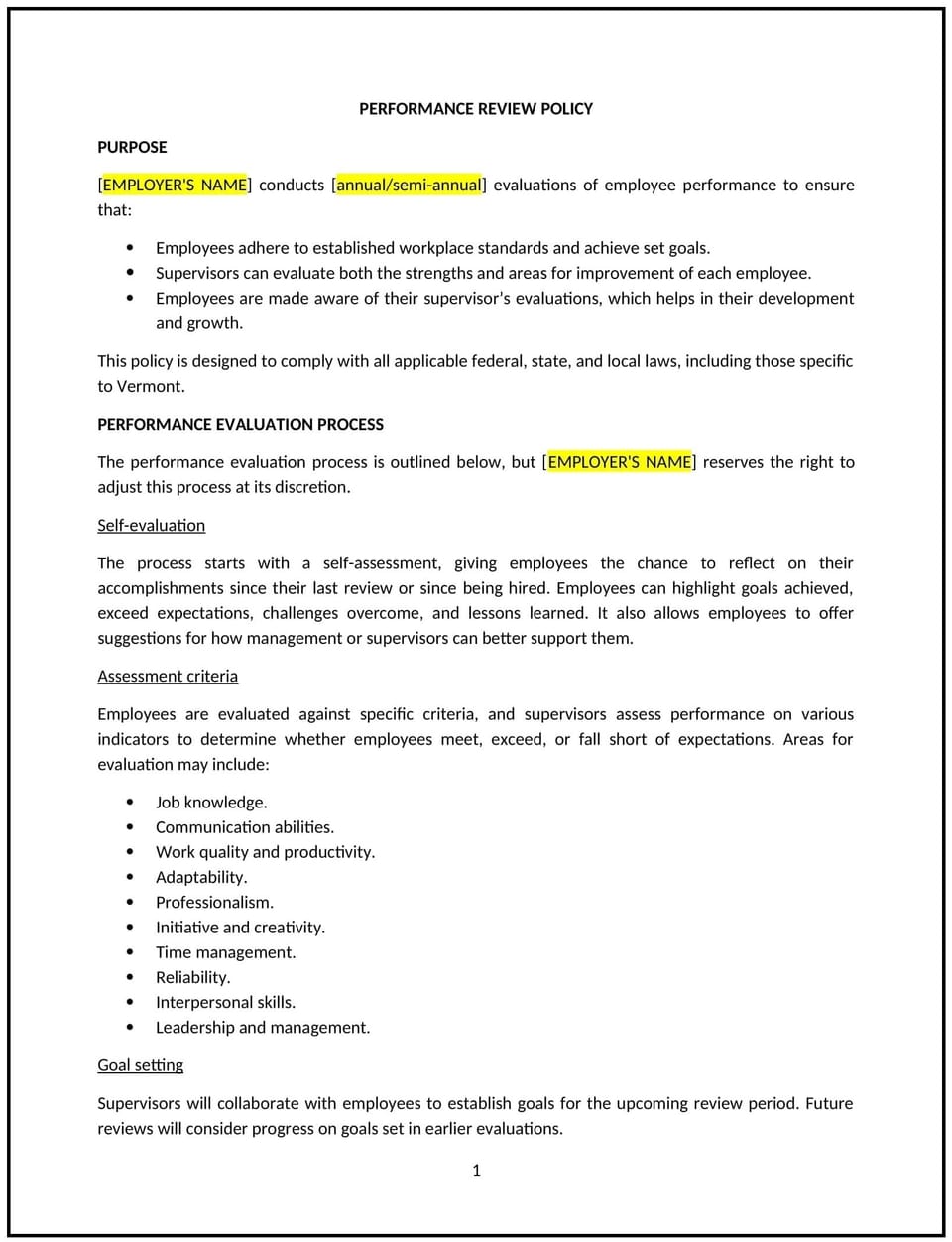Performance review policy (Vermont): Free template

Performance review policy (Vermont)
This performance review policy is designed to help Vermont businesses establish a consistent and constructive approach to evaluating employee performance. It outlines guidelines for review frequency, evaluation criteria, and feedback delivery to ensure alignment with organizational goals and employee development.
By adopting this policy, businesses can promote transparency, encourage growth, and enhance workplace productivity.
How to use this performance review policy (Vermont)
- Define review frequency: Specify how often performance reviews are conducted, such as annually, semi-annually, or quarterly.
- Include evaluation criteria: Outline the factors used to assess performance, such as job-specific goals, teamwork, communication, and overall contributions.
- Establish review formats: Provide options for review formats, such as written evaluations, one-on-one meetings, or 360-degree feedback.
- Address feedback delivery: Encourage constructive and actionable feedback to help employees understand strengths and areas for improvement.
- Link reviews to development: Highlight opportunities for training, promotions, or performance improvement plans based on review outcomes.
- Emphasize fairness: Ensure performance reviews are conducted impartially and consistently across all employees.
- Monitor effectiveness: Regularly review the performance evaluation process to align with Vermont laws and workplace objectives.
Benefits of using this performance review policy (Vermont)
This policy provides several benefits for Vermont businesses:
- Enhances transparency: Establishes clear expectations for employee performance and career growth.
- Supports development: Encourages employees to focus on professional growth and align with organizational goals.
- Promotes fairness: Ensures consistent evaluation practices across all departments and employees.
- Improves communication: Facilitates open and constructive dialogue between employees and managers.
- Boosts productivity: Aligns individual performance with business objectives, driving organizational success.
Tips for using this performance review policy (Vermont)
- Communicate the policy: Share the policy with employees during onboarding and include it in the employee handbook or internal systems.
- Train managers: Provide training on conducting fair and constructive performance reviews, including delivering feedback and setting goals.
- Document evaluations: Maintain records of performance reviews, feedback, and improvement plans to track employee progress and support future decisions.
- Encourage self-assessments: Allow employees to reflect on their performance and goals as part of the review process.
- Update regularly: Revise the policy to reflect changes in Vermont laws, company objectives, or industry best practices.
Q: How often should performance reviews be conducted?
A: Performance reviews are typically conducted annually, but some businesses may choose more frequent evaluations, such as semi-annual or quarterly reviews, based on organizational needs.
Q: What criteria should businesses use for evaluations?
A: Businesses should evaluate performance based on job-specific goals, collaboration, communication, problem-solving, and overall contributions to the organization.
Q: How can businesses ensure fair performance reviews?
A: Fair reviews can be ensured by standardizing evaluation criteria, training managers, and using objective metrics to assess performance.
Q: What should be included in feedback during a review?
A: Feedback should be constructive, actionable, and focused on strengths, areas for improvement, and specific steps for development.
Q: Can performance reviews be linked to promotions or raises?
A: Yes, performance reviews can inform decisions about promotions, raises, or other rewards, but businesses should communicate clear guidelines for how evaluations influence such decisions.
Q: How should businesses handle poor performance identified in reviews?
A: Businesses should address poor performance through a performance improvement plan (PIP) that includes specific goals, timelines, and support for improvement.
Q: How often should this policy be reviewed?
A: This policy should be reviewed annually or whenever significant changes occur in Vermont labor laws or organizational practices.
Q: Can businesses use technology for performance reviews?
A: Yes, performance management software can streamline the review process, track progress, and provide data-driven insights.
This article contains general legal information and does not contain legal advice. Cobrief is not a law firm or a substitute for an attorney or law firm. The law is complex and changes often. For legal advice, please ask a lawyer.


